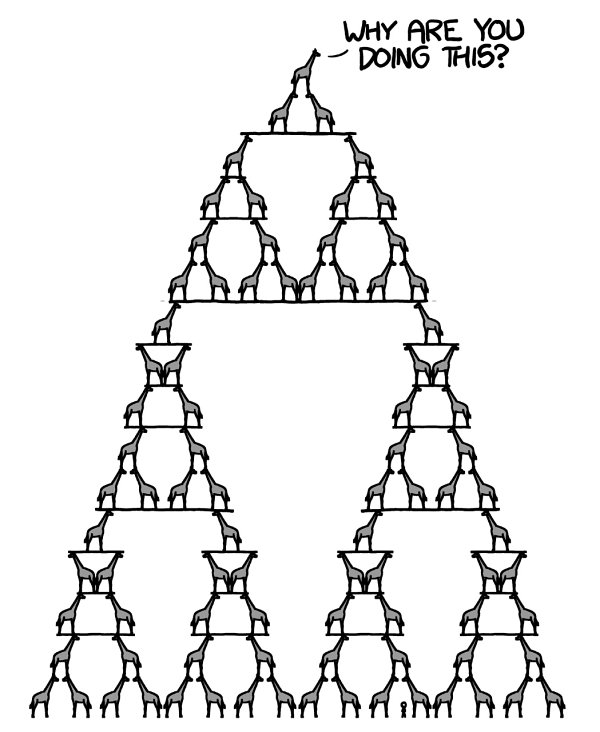What If? (27 page)
Authors: Randall Munroe

Th
en the selected strands would be contributed to the child:
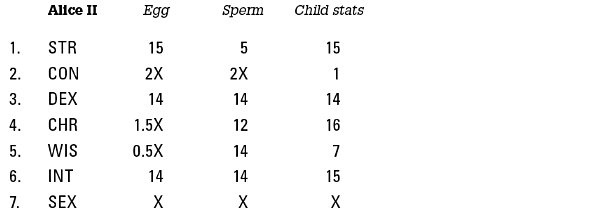
Th
e child is guaranteed to be female, since there’s nobody to contribute a Y chromosome.
Th
e child also has a problem: For three of her seven stats
—
INT
,
DEX
, and
CON
—
she inherited the same chromosome on both sides.
Th
is isn’t a problem for
DEX
and
CON
, since Alice had a high score in those two categories, but in
CON
,she inherited a multiplier from both sides, giving her a constitution
score of 1.
If someone produces a child on their own, it dramatically increases the likelihood that the child will inherit the same chromosome on both sides, and thus a double multiplier.
Th
e odds of Alice’s child having a double multiplier are 58 percent
—
compared to the 25 percent chance for a child with Bob.
In general, if you have a child with yourself, 50 percent of your chromosomes
will have the same stat on both sides. If that stat is a 1
—
or if it’s a multiplier
—
the child will be in trouble, even though you might not have been.
Th
is condition, having the same genetic code on both copies of a chromosome, is called
homozygosity
.
Humans
In humans, probably the most common genetic disorder caused by inbreeding is spinal muscular atrophy (
SMA
).
SMA
causes the death of
the cells in the spinal cord, and is often fatal or severely disabling.
SMA
is caused by an abnormal version of a gene on chromosome 5. About 1 in 50 people have this abnormality, which means 1 in 100 people will contribute it to their children . . . and, therefore, 1 in 10,000 people (100 times 100) will inherit the defective gene from
both
parents.
2
If a parent has a child with his-
or herself, on the other hand, the chance of
SMA
is 1 in 400
—
since if he or she has a copy of the defective gene (1 in 100), there’s a 1 in 4 chance it will be the child’s
only
copy.
One in 400 may not sound so bad, but
SMA
is only the start.
DNA is complicated
DNA
is source code for the most complex machine in the known universe. Each chromosome contains a staggering amount of information,
and the interaction between
DNA
and the cell machinery around it is incredibly complicated, with countless moving parts and Mousetrap-style feedback loops. Even calling
DNA
“source code” sells it short
—
compared to
DNA
, our most complex programming projects are like pocket calculators.
In humans, each chromosome affects many things through a variety of mutations and variations. Some of these
mutations, like the one responsible for
SMA
, seem to be entirely negative; the mutation responsible has no benefit. In our D&D system, it’s like a chromosome having an
STR
of 1. If your other chromosome is normal, you’ll have a normal character stat; you’ll be a silent “carrier.”
Other mutations, like the sickle-cell gene on chromosome 11, can provide a mix of benefit and harm. People who
have the sickle-cell gene on both their copies of the chromosome suffer from
sickle-cell anemia.
However, if they have the gene on just
one
of their chromosomes, they get a surprise benefit: extra resistance to malaria.
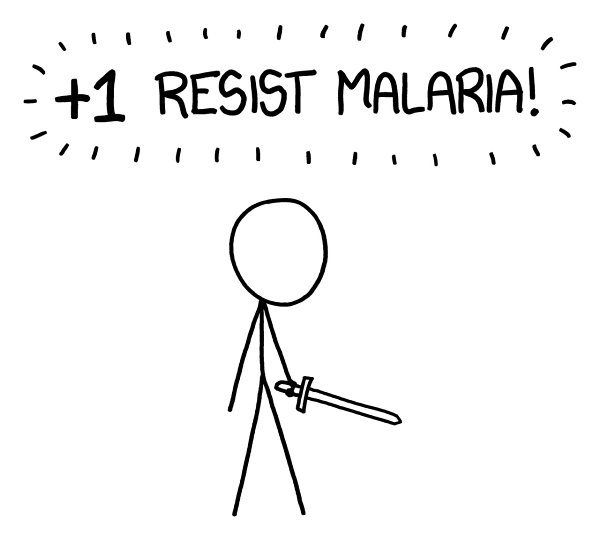
In the D&D system, this is like a “2x” multiplier. One copy of the gene can make you stronger, but two copies
—
double multipliers
—
lead to a serious disorder.
Th
ese two diseases illustrate one reason that genetic diversity is important. Mutations pop up all over the place, but our redundant chromosomes help blunt this effect. By avoiding inbreeding, a population reduces the odds
that rare and harmful mutations will pop up at the same place on both sides of the chromosome.
Inbreeding coefficient
Biologists use a number called the “inbreeding coefficient” to quantify the percentage of someone’s chromosomes that are likely to be identical. A child from unrelated parents has an inbreeding coefficient of 0, while one who has a completely duplicated set of chromosomes
has an inbreeding coefficient of 1.
Th
is brings us to the answer to the original question. A child from a parent who self-fertilized would be like a clone of the parent with severe genetic damage.
Th
e parent would have all the genes the child would, but the child wouldn’t have all the genes of the parent. Half the child’s chromosomes would have their “partner” chromosomes replaced by a copy
of themselves.
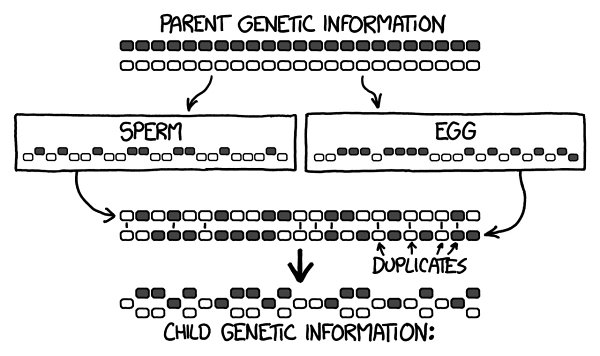
Th
is means the child would have an inbreeding coefficient of 0.50.
Th
is is very high; it’s what you would expect in a child of three generations of consecutive sibling marriages. According to D. S. Falconer’s
Introduction to Quantitative Genetics,
an inbreeding coefficient of 0.50 would result in an average of a 22-point reduction in IQ and a 4-inch reduction in height at age ten.
Th
ere would be a very good chance that the resulting fetus would not survive to birth.
Th
is kind of inbreeding was famously exhibited by royal families attempting to keep their bloodlines “pure.”
Th
e European House of Hapsburg, a family of European rulers from the mid-second millennium, was marked by frequent cousin marriages, culminating in the birth of King Charles II of Spain.
Charles
had an inbreeding coefficient of 0.254, making him slightly more inbred than a child of two siblings (0.250). He suffered from extensive physical and emotional disabilities, and was a strange (and largely ineffective) king. In one incident, he reportedly ordered that the corpses of his relatives be dug up so he could look at them. His inability to bear children marked the end of that royal bloodline.
Self-fertilization is a risky strategy, which is why sex is so popular among large and complex organisms.
3
Th
ere are occasionally complex animals that reproduce asexually,
4
but this behavior is relatively rare. It typically appears in environments where it’s difficult to reproduce sexually, whether due to resource scarcity, population isolation . . .

Life finds a way.
. . . or overconfident theme park operators.
- 1
Because 1 is the multiplicative identity.
- 2
Some forms of SMA are actually caused by a defect in
two
genes, so in practice the statistical picture is a little more complicated.
- 3
Well, one of the reasons.
- 4
“Tremblay’s
Salamander” is a hybrid species of salamander that reproduces exclusively by self-fertilizing.
Th
ese salamanders are an all-female species, and
—
strangely
—
have three genomes instead of two. To breed, they go through a courtship ritual with male salamanders of related species, then lay self-fertilized eggs.
Th
e male salamander gets nothing out of it; he’s simply used to stimulate egg-laying.
High
Th
row
Q.
How high can a human throw something?
—Irish Dave on the Isle of Man
A.
Humans are good at
throwing things. In fact, we’re great at it; no other animal can throw stuff like we can.
It’s true that chimpanzees hurl feces (and, on rare occasions, stones), but they’re not nearly as accurate or precise as humans. Antlions throw sand, but they don’t aim it. Archerfish
hunt insects by throwing water droplets, but they use specialized mouths instead of arms. Horned lizards shoot jets of blood from their eyes for distances of up to 5 feet. I don’t know
why
they do this because whenever I reach the phrase “shoot jets of blood from their eyes” in an article I just stop there and stare at it until I need to lie down.
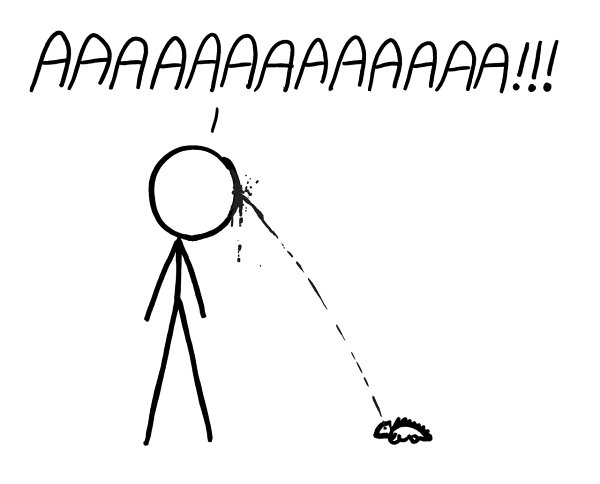
So while there are other animals that use projectiles, we’re just about the only animal that can grab a random object and reliably nail a target. In fact, we’re so good at it that some researchers have suggested that rock-throwing played a central role in the evolution of the modern human brain.
Th
rowing is hard.
1
In order to deliver a baseball to a batter, a pitcher has to
release the ball at exactly the right point in the throw. A timing error of half a millisecond in either direction is enough to cause the ball to miss the strike zone.
To put that in perspective, it takes about
five
milliseconds for the fastest nerve impulse to travel the length of the arm.
Th
at means that when your arm is still rotating toward the correct position, the signal to release the
ball is already at your wrist. In terms of timing, this is like a drummer dropping a drumstick from the tenth story and hitting a drum on the ground
on the correct beat
.
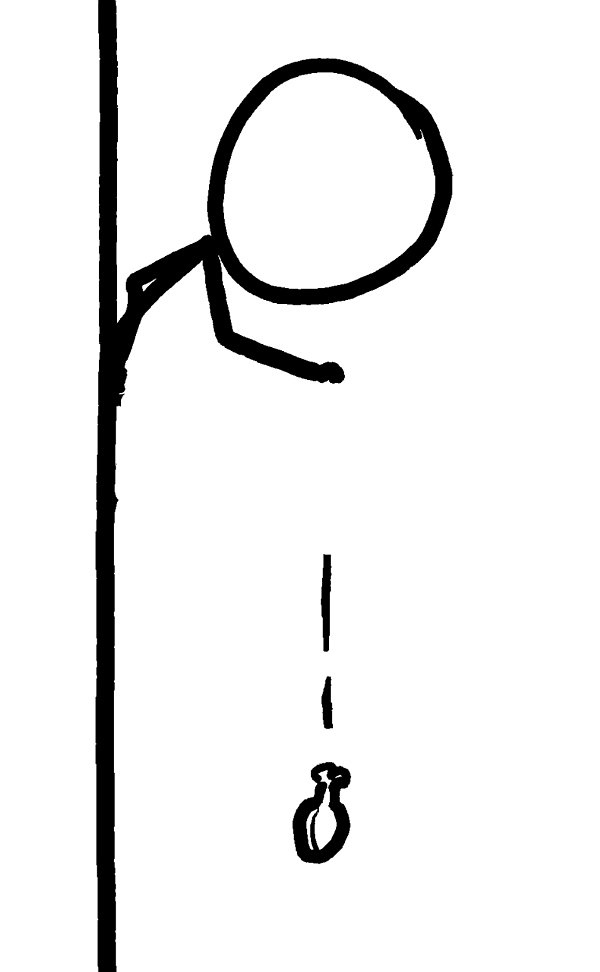
We seem to be much better at throwing things forward than throwing them upward.
2
Since we’re going for maximum height, we could use projectiles that curve upward when you throw them forward; the Aerobie Orbiters I had when I was a kid often got stuck in the highest treetops.
3
But we could also sidestep the whole problem by using a device like this one:

A mechanism for hitting yourself in the head with a baseball after a four-second delay
We could use a springboard, a greased chute, or even a dangling sling
—
anything that redirects the object upward without adding to or subtracting from its speed. Of course, we could also try this:
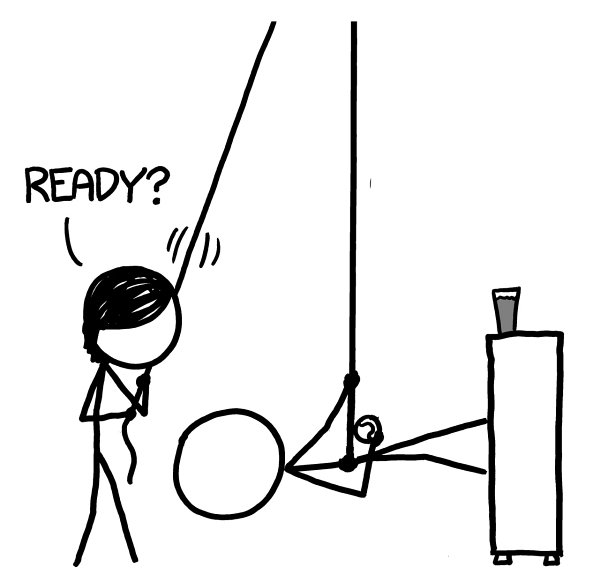
I ran through the basic aerodynamic calculations for a baseball thrown at various speeds. I will give these heights in units of giraffes:
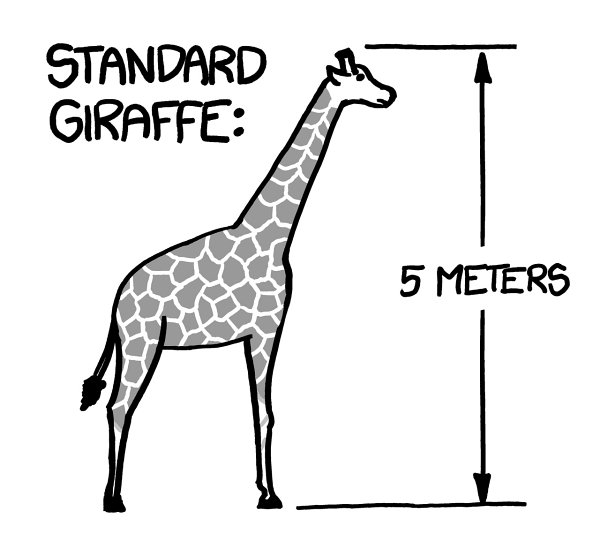
Th
e average person can probably throw a baseball at least three giraffes high:
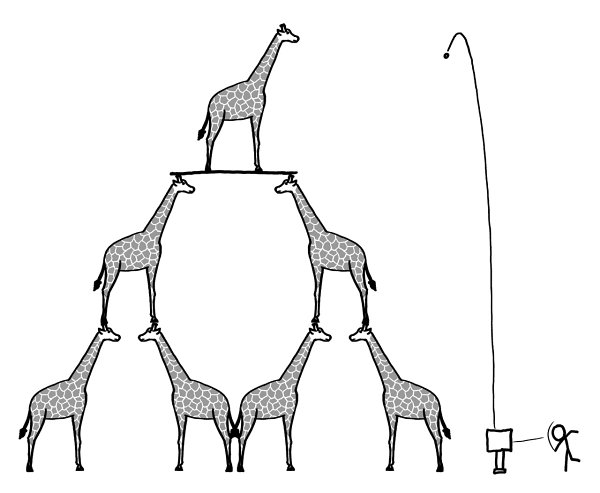
Someone with a reasonably good arm could manage five:
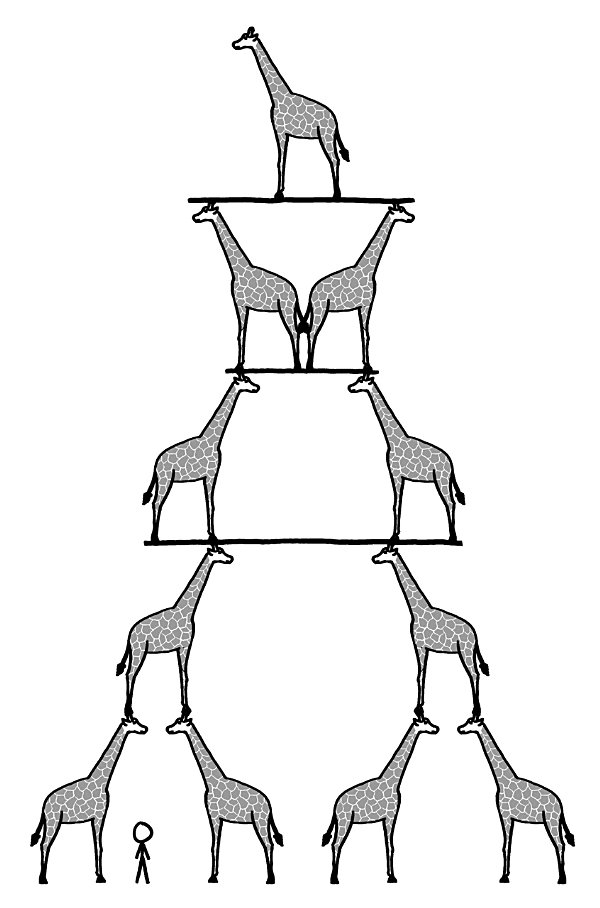
A pitcher with an 80 mph fastball could manage ten giraffes:
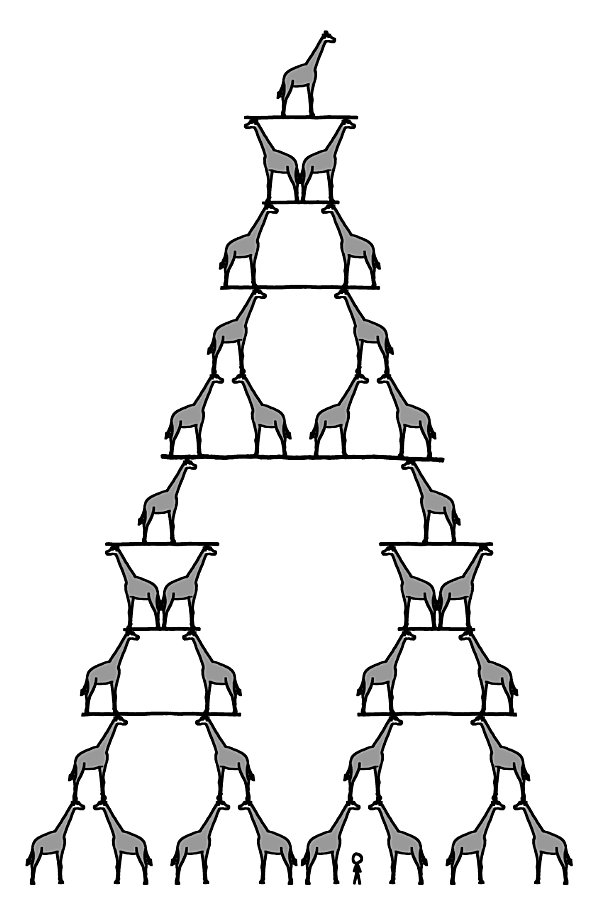
Aroldis Chapman, the holder of the world record for fastest recorded pitch (105 mph), could in theory launch a baseball 14 giraffes high:
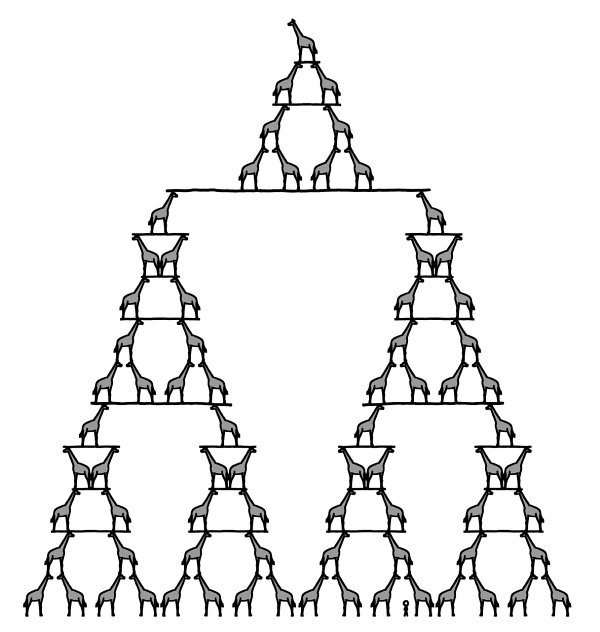
But what about projectiles other than a baseball? Obviously, with the aid of tools like slings, crossbows, or the curved
xistera
scoops in jai alai, we can launch projectiles much faster than that. But for this question, let’s assume we stick to bare-handed throwing.
A baseball is probably not the ideal projectile, but it’s hard to find speed data on other kinds of thrown objects.
Fortunately, a British javelin thrower named Roald Bradstock held a “random object throwing competition,” in which he threw everything from dead fish to an actual kitchen sink. Bradstock’s experience gives us a lot of useful data.
4
In particular, it suggests a potentially superior projectile: a golf ball.
Few professional athletes have been recorded throwing golf balls. Fortunately, Bradstock
has, and he claims a record throw of 170 yards.
Th
is involved a running start, but even so, it’s reason to think that a golf ball might work better than a baseball. From a physics standpoint, it makes sense; the limiting factor in baseball pitches is the torque on the elbow, and the lighter golf ball might allow the pitching arm to move slightly faster.
Th
e speed improvement from using a golf
ball instead of a baseball would probably not be very large, but it seems plausible that a professional pitcher with some time to practice could throw a golf ball faster than a baseball.
If so, based on aerodynamic calculations, Aroldis Chapman could probably throw a golf ball about sixteen giraffes high:
